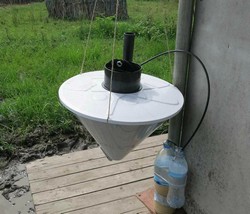Novel devices to fend off the malaria mosquito
Malaria infects 300 million people worldwide each year. It is a massive threat to public health and an economic burden, particularly in resource-poor societies. The EU-funded MCD(opens in new window) (A low cost mosquito contamination device for sustainable malaria mosquito control) project set out to develop low-cost mosquito contamination devices (MCDs) to help tackle the problems of current mosquito control tools, which are ineffective due to chemical resistance. To attract and kill malaria mosquitoes, project partners developed three MCD prototypes: the Eave tube, the Smart patch and the Outdoor host-seeking device. The Eave tubes exploit African malaria mosquitoes' preference for entering houses through an eave – the gap between the roof and walls. An airstream passes through the tube, attracting mosquitoes with the human smells from inside the house. Mosquitoes are blocked and killed by a netting insert treated with special powder-formulated insecticides when they try to enter the house through the tube. The second MCD consists of an insecticide-treated netting patch that can be strategically placed on top of a bednet. Malaria mosquitoes have a tendency to make their way towards a bednet's ceiling directly above the sleeper's torso and head. The Smart Patch enables a safe point-source application of novel chemistries to kill resistant malaria vectors. Outdoor MCDs are small, portable devices that can be placed near houses or cattle sheds in order to take advantage of odours emitted from such sources. They minimise human exposure to outdoor biting mosquitos. Overall outcomes are encouraging. Eave tube coverage reached 79 % in Mngeta in southern Tanzania, where close to 10 000 inhabitants received protection against malaria mosquitoes. They provide a low-cost, effective intervention that can be integrated into malaria vector control programmes. Smart patches show promise as a cost-effective tool, improving mosquito kill rates by 50 % with minimal amounts of insecticide. Research on outdoor MCDs shows that stand-alone devices without the need for electricity can successfully attract and kill malaria mosquitos. MCD's low-cost and user-friendly technologies are an effective complement to current vector control tools. They can also be deployed in areas where there is no power sources or great infrastructure available yet in order to tackle severe human health issues caused by malaria.







